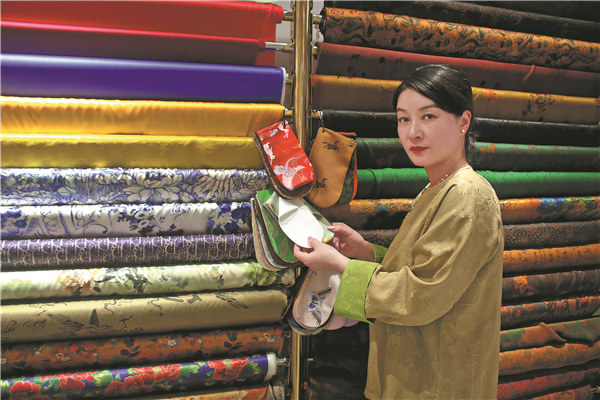
Zhu Wenjun leans on nostalgia to revive Manchu elegance
In Jilin Qipao Hall of Jilin city, Jilin province, the employees are tasked with selecting materials, fastening buttons, crafting inlays, cutting fabrics and sewing inlays and trims. They are artists, designers, and keepers of cultural tradition.
Jilin city is one of the birthplaces of the ethnic minority Manchu people. The Manchu cheongsam, a type of qipao, integrates multiple intangible cultural heritage techniques.
Born into a Manchu family, Zhu Wenjun, the hall's founder, developed a passion for cheongsams during her childhood.
"In Manchu tradition, all the girls must know how to sew," said 52-year-old Zhu. "My grandmother, who was skilled at needlework, made a living from sewing, so I started learning the skills from her at the age of 5."
By the time she was in primary school, she could sew bedcovers with sharp edges and corners.
"Before major festivals, such as the Spring Festival, my grandmother would make traditional Manchu clothes for me, such as bloomers and tiger-head shoes," she recalled. "Her embroidery, such as pillow covers and door curtains, were welcomed by relatives and neighbors when they prepared for marriage."
Zhu still remembers the beautiful cheongsam that her grandmother only wore on special occasions.
"She never let me touch it, which made me greatly desire to possess one," she said. "As I grew older, I began to understand the significance of clothing in Manchu families, which is not just a necessity, but also represents culture, status and family heritage."
After graduating from a local secondary technical school in 1993, Zhu became a civil servant in Jilin city, but she retained her fondness for cheongsams.
In 2005, Zhu quit her job and opened a tailor shop with her husband.
"Together with three tailors, we helped our customers choose suitable fabrics and tailor clothing, and sometimes we collaborated with other shops," she said. "Although I didn't make much money, I found fulfillment."
They expanded their shop in 2009 and added more employees. Throughout her success, she never forgot about her dream of owning the perfect cheongsam.
"While visiting different cheongsam shops, I found it difficult to find one that could provide me with satisfactory fabrics, patterns and tailoring skills simultaneously," Zhu lamented. "I believed it wasn't about the tailors' skills but rather the lack of effective coordination, leading to clothing that fell short of ideal."
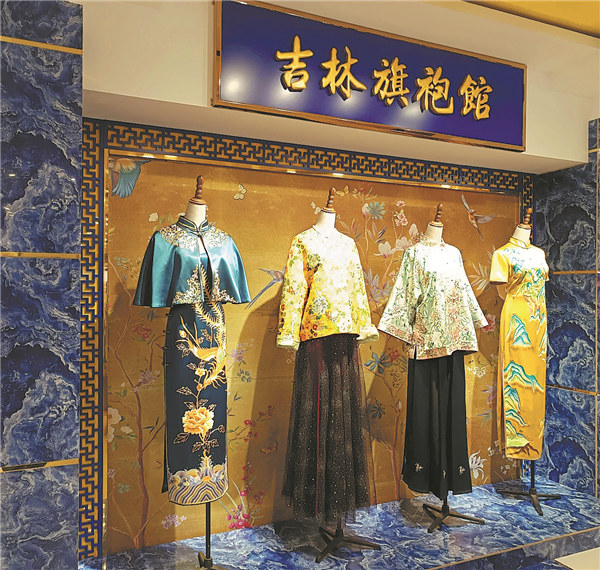
She invited several skilled cheongsam tailors she had worked with and turned her shop into the current Qipao Hall in 2012.
Zhu has her own interpretation of inheritance.
"Preserving the belongings of ancestors is the best form of inheritance," she said. "I used traditional Manchu techniques to embroider patterns left by the elders onto the clothing."
Furthermore, she delved into the more primitive memories of Manchu clothing in Jilin city, striving to restore them as much as possible.
While searching, she discovered her calling: to craft unique Manchu embroidery that reflects the essence of the region. Her designs seamlessly blend elements such as fishing, hunting, ice and snow, and cultural expressions of the tradition of labor.
In 2019, Zhu became a municipal-level inheritor of traditional Manchu embroidery.
At Zhu's Qipao Hall, clients must wait seven to 15 days for their custom cheongsams.
"The customers first choose the fabric and style, and then the tailor takes measurements," she said. "After three days, they can try on the samples, and the tailor will make corrections. Embroidered patterns will be matched based on the customer's height and stature."
Depending on the fabric and style, the price of each custom cheongsam varies from several hundred yuan to tens of thousands of yuan.
"In the beginning, most of my clients were middle-aged and elderly people who wanted to participate in important occasions, such as their children's weddings," Zhu explained. "In recent years, with the popularity of Chinese-style clothing, Manchu cheongsams have also attracted young people."
"Some mothers and teachers are choosing to wear qipao to cheer on students taking life-altering exams, such as the college entrance exam, or gaokao, and the senior high school entrance exam," she said.
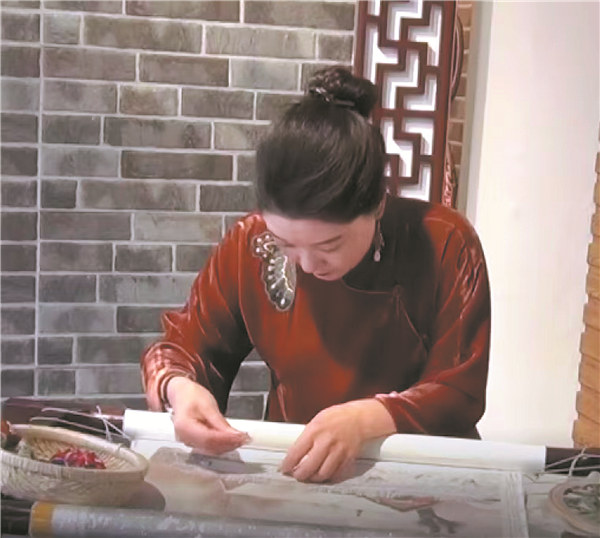
In Mandarin, the character qi also refers to a flag, symbolizing victory, courage and good luck.
To adapt to young people who make specific requests to showcase their individuality, the designers at Qipao Hall have started incorporating modern elements and fashion design. "In some situations where cheongsams may not be suitable, we have developed cheongsam-related products such as bags and outerwear with buttons and trims," Zhu said.
The hall now has over 50 employees and an annual output value of 16 million yuan. More than 30 percent of orders come from abroad.
"Most of the foreign orders came from Chinese who wanted to show the traditional Chinese culture in foreign countries, such as Australia, Canada, Japan, the USA and the UK," she said. "Some mothers told me they were quite proud of wearing a cheongsam to attend their children's graduation ceremony, and some even customized cheongsams for their daughters."
In 2019, Zhu opened a Qipao Hall in Shenzhen, Guangdong province, attracting more customers from the province, Hong Kong, Macao and Singapore.
"Young people and Chinese abroad are more interested in traditional Chinese culture," said Pi Fusheng, a researcher of literature and history with the city's Committee of the Chinese People's Political Consultative Conference. "Cheongsams make them feel the charm of traditional culture and enhances cultural identity and pride."
"On the basis of maintaining the uniqueness and cultural value of intangible cultural heritage, inheritors and practitioners should be encouraged to innovate," he said. "The design of new products and the improvement of the process make the intangible heritage full of new vitality."
Han Junhong contributed to this story.
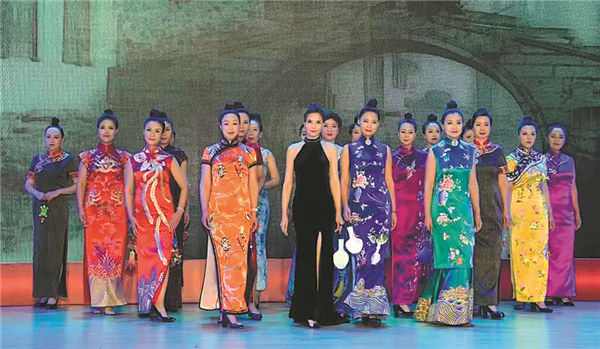
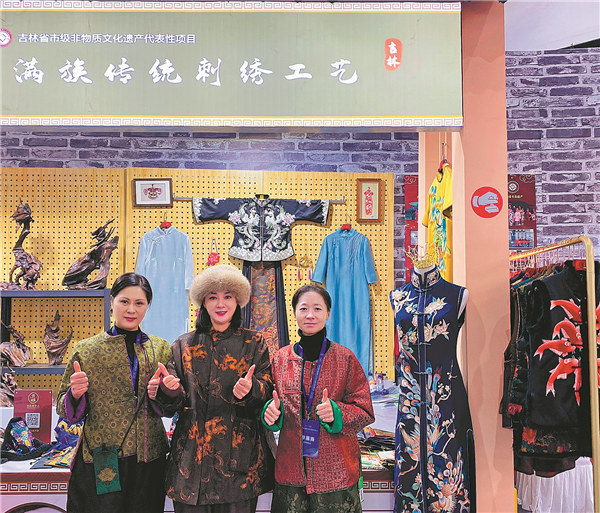

Korean vlogger dedicated to documenting the real China

Last-minute turnovers cause China's loss to Spanish club Joventut in basketball friendly

Hall of Famer O'Meara chooses Pebble Beach to call it quits

China activates emergency response to flooding

Kane fires four in 9-goal rout of Zagreb

Athletics legend Coe to vie with six rivals for IOC presidency